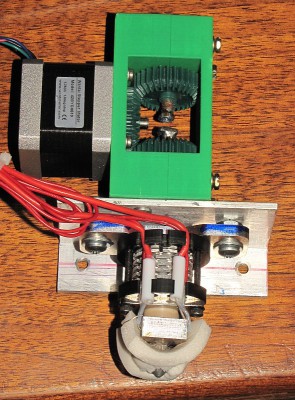One of the biggest problems with FDM 3D printing is hot-end jamming. There seem to be a lot of causes, most of which are not readily identifiable when a jam occurs. One thing I have found is that after a hot-end jam I can usually grab the filament and manually push it and get it flowing through the hot-end again, though it is too late to save the failed print. The most common means of driving the filament into the hot-end is to pinch the filament between a gear and a bearing and have a motor drive the gear, either directly (with 1.75mm filament) or via a gear reduction/torque multiplier arrangement (3mm filament). When the hot end jams, the large force applied by the gear over the small area of the filament that is pinched between the gear and bearing usually chews a divot in the filament thus destroying the grip.
A couple weeks ago I started designing a 3mm filament extruder for 3D printing. My hope is that this extruder will provide sufficient force on the filament to prevent hot-end jamming from ruining prints. My design uses two counter-rotating 6-32 nuts twisting on the filament (like the way your hands twist in opposite directions when you give a “snakebite” to your friend) to drive it into the hot-end. One is a normal, right-hand threaded nut, the other is left-hand threaded. When the nuts turn in opposite directions, the torque that would try to twist the filament is cancelled while moving the filament forward and reverse without twisting.
The motor has to turn about 1.26 times to move 1mm of filament so there is a huge torque to axial force conversion. The gear diameter is about 30mm. That 1.26 rev moves the gear about 119mm at its perimeter. That means there is about a 119:1 increase (ignoring losses in the gears, bearings, and nuts) in the force at the filament compared to the force at the gear. That force is applied over a larger area of the filament than the usual pinch arrangement, so it is less likely (I hope!) to carve the filament and lose grip. I tried stopping the filament by grabbing it with my fingers and holding as tightly as I could but it didn’t even slow down.
The firmware in the printer has to be tweaked so that it knows exactly how many steps of the motor are required to drive 1mm of filament. The formula is:
32 rev/ 1 inch X 1 inch /25.4 mm X 200 steps/1 rev X 16 microsteps/1 step = 4031.496 microsteps/mm
For initial tests I just input 4031.5 using the rotary encoder on the LCD interface to the RAMPS board in MegaMax.
Here are the parts that I used:
Left hand threaded tap: http://www.amazon.com/gp/product/B006YITGY8
5mm brass tubing: http://www.ebay.com/itm/360828686174
5x16x5mm (625Z) bearings: http://www.ebay.com/itm/321062568303
Plastic gears: http://www.sciplus.com/p/PLASTIC-GEAR-SET-WITH-BUSHINGS_40234
I also used a NEMA-17 motor from a QU-BD extruder.
You can DL the STL files for the printed parts here: http://www.thingiverse.com/thing:261037
Test printing will start in the next day or so and I will post another video showing success or failure.
Fingers crossed!
